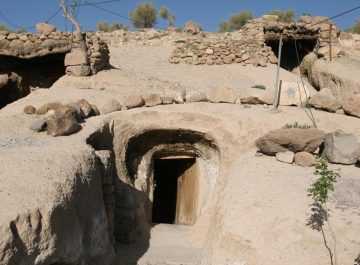The last troglodytes of IRAN
The last troglodytes of IRAN
An ancient troglodyte-style cave dwellings ! estimated to be more than 10,000 years old.
An ancient cave village
Iran’s ancient village of Maymand, located around 900km south of the capital Tehran, is littered with troglodytic dwellings ‒ cavernous, underground homes carved out of soft rock. Stone engravings found at the site are estimated to be more than 10,000 years old.
A Unesco World Heritage Site, Maymand is said to have been inhabited continuously for more than 2,000 years, which makes it one of Iran’s oldest surviving villages. (Credit: Rodolfo Contreras)
Seasonal housing
Tucked away in a valley within the arid mountains of central Iran, Maymand experiences extremely hot summers and severely cold winters. To adapt to these harsh conditions, villagers switch homes according to the season.
In the summer and early autumn, they live in homes with grass thatch roofs which help protect them from the oppressive heat. When temperatures plummet and bone-chilling winds sweep the valley, Maymand residents move underground. (Credit: Rodolfo Contreras)
Winter caves
Of the 400 caves built more than 10,000 years ago, 90 remain intact. These cave homes can contain up to seven rooms, each about 2m tall and 20m squared, although size varies from cave to cave. (Credit: Rodolfo Contreras)
Modern living
Residents have updated the caves to suit their lifestyle: they have electricity, which allows for refrigeration, and even televisions. However, there is no running water, and ventilation is minimal. The dark film that covers some of the walls is a result of the soot from the fires used to cook or heat the rooms. (Credit: Rodolfo Contreras)
Remnants of an ancient past
The village once followed the ancient mystical religion of Zoroastrianism, which prospered under Persian rule. Vestiges of Maymand’s spiritual past remain, like the Kicheh Dobandi, a cave that is said to have once been a temple (and is now a small museum). In the 7th Century, Islam overtook Zoroastrianism as the primary religion in Maymand, and today, the caves are home to one of the few cave mosques in the world (pictured). (Credit: Rodolfo Contreras)
Nomadic shepherds
The majority of the villagers are agro-pastoralists, raising cattle on mountain pastures and bringing the animals with them when they migrate to the caves, which feature underground stables. Residents also collect medicinal plants, which they claim help them achieve good health and long lives. (Credit: Rodolfo Contreras)
A disappearing lifestyle
Today, fewer people are choosing to live in the caves, instead moving to neighbouring towns in the winter and returning in the summer. Only an estimated 150 people populate the village throughout the year. (Credit: Rodolfo Contreras)
Preserving a legacy
The dwindling year-round population poses a threat to the survival of Maymand’s unique lifestyle. In 2001, the Iranian Cultural Heritage, Handicrafts and Tourism Organization has worked to raise awareness of Maymand. Since then, the village has received more visitors; today Maymand even has caves where tourists can stay the night to experience a way of life that has persisted for millennia. (Credit: Rodolfo Contreras)










